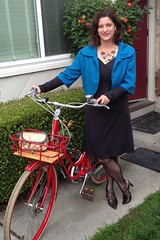You may recognize Leah from a Fashion Friday photos I shot the day I rode with her on her first Bay Area Bike Share commute just after the system launched last summer. As the Director of SPUR San Jose, Leah works in San Jose four days a week and spends the fifth day at SPUR headquarters 50 miles away in San Franscisco. As an urbanist she defaults to non-driving travel and she’s fortunate to have many transit and bike options available. That makes her Anything Goes Commute Challenge all the more interesting. This is her story.
When Janet asked me to capture not only my commute modes to and from work, but my decision process for each mode, I was anxious to oblige. I had been meaning to see if the data backed up my first choice, my bicycle. As a long time bike lover, it’s my default mode of transportation if given an option. But is it really the most effective? And so here goes – a data comparison of the top ways I can get to work.

I live two miles from the SPUR office in San Jose. My commute streets are laid out in a straight-forward, flat grid pattern, beginning in Japantown and ending in downtown San Jose. I travel this commute four days a week and head to our office in San Francisco’s Yerba Buena district one day a week.
This October I set out to find out which of my various commutes took the most time, money, energy, planning, etc. And like those combination math problems in middle school, I took to testing the options and used simple parameters: door to door time, ease of travel, cost. Here are the options for my San Jose commute:
Bike (my own)
There are several connecting bike lanes along Third and Fourth Street and low auto traffic speeds that make it particularly easy to commute by bike. We also have a bike rack outside of our office so I can lock up securely.

Walk + VTA Light Rail + Walk
The Light Rail Stations near work are on the same block as our office, which make arrival to and departure from work very convenient. I’m only three stops from work from where I get on at Civic Center and from there it’s about a 10 minute walk home from the station. This works best when I am looking for a walking start and finish to the day, but I need to pay more attention to time in order to catch the train when I arrive at the station and weight/amount of material I need to take to work with me (i.e. carry).

Walk + Bike Share + Walk
The closest bike share station to my house is in Japantown and the closest station to work is at City Hall. Getting to and from this option require upwards of 15 minutes of walking, but the bike share bikes are great with an upright position and place for my bag in front.

Drive
My car commute is a pretty straight forward two mile drive with low traffic. Early bird (arrival before 9:45am) parking at the garage across the street from my office costs $8 for the day.

First consideration for commute choice begins with how I organize my calendar. I make a point to coordinate my work meetings and personal errand running to the following criteria (as much as possible):
- Schedule as many meetings as possible within walking distance of the office so that I don’t have to drive. Aim for this 3-4 days a week.
- Schedule meetings that require car travel all on the same day. Typically, meetings outside of downtown San Jose or more than 1-2 Light Rail stops away default to driving to maximize efficiency (and because there is rarely a parking cost on the other end of meetings).
- On days that require car travel, plan errand running (dry cleaners, grocery shopping, ‘big’/bulk shopping, etc) on the same day.
Second consideration with commute choice is weather. Unless it’s raining or aiming to be 90 degrees, I’ll choose not to drive. Otherwise, with such flat terrain and short distance, it’s easy to walk, bike or take transit. Third consideration is time. What is the quickest way I can get where I need to go and how can I travel most efficiently between meetings? Fourth consideration is money. How much will it cost in work time (driving vs. Caltrain), gas and parking vs. the alternatives.
There are other considerations that pop in and out and impact my mode decision (if I need to move things in and out of the office, if I feel at all under the weather, if my bike is out of commission (or stolen…it’s happened), if my work day will go very late, etc), but these are the less frequent occasions.

The options for my San Francisco commute are to ride my bike to Caltrain San Jose station, take it aboard and bike to the SPUR headquarters in San Francisco, or drive to Caltrain and walk from the San Francisco station to the office, or drive and pay for garage parking.


The Upshot: What I didn’t add above were the other benefits that come with each mode. With any mode except the car, there is exercise, time outdoors and in my neighborhood, taking a car and its CO2 emissions off the road and usually the opportunity to discover something new along the route. But with the car comes a slightly faster commute, complete independence and, at $8 a day for parking, not a terribly expensive option, especially for one day a week. Adding that up over time though would equate to a great deal of cash and it’s quickly the lease desirable option by virtue of cost. And so my winning option is – bike commute!



































